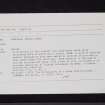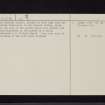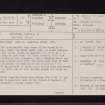Dumfries, Castle Street
Fortified House (Period Unassigned)
Site Name Dumfries, Castle Street
Classification Fortified House (Period Unassigned)
Alternative Name(s) Maxwell's Castle
Canmore ID 65538
Site Number NX97NE 15
NGR NX 9712 7629
Datum OSGB36 - NGR
Permalink http://canmore.org.uk/site/65538
- Council Dumfries And Galloway
- Parish Dumfries
- Former Region Dumfries And Galloway
- Former District Nithsdale
- Former County Dumfries-shire
NX97NE 15 9712 7629.
(NX 9712 7629) Site of Dumfries Castle (NR)
OS 1:1056 map (1852)
The battlemented town house of the Maxwells at Dumfries, which was built about 1545, is often referred to as the second castle of Dumfries (cf NX97SE 2). It is said to have been 'of three storeys, with four large vaults in the basements, and a turnpike stair and bartizan covered with lead; and there were four or five acres of ground attached to it and walled in'. It was in need of repair when troops were garrisoned there in 1675, and in 1724 the New Church was built on the site.
J Barbour 1890; 1907
Stone from the Greyfriars Friary (NX97NE 13) was alleged to have been used in the repair of Maxwell of Caerlaverock's 'castle' after 1570.
SBS Dumfries 1977; W McDowell 1867
Four heraldic panels, reputed to have come from the 16th century town-house of the Maxwell family, which stood on the site of the modern Greyfriars Church, are built into rockeries in the garden of a villa, St Christopher's in St Mary Street. They were part of the collection of the late James Barbour.
RCAHMS 1920, visited 1915
A collection of very ancient clay pipe-heads found while excavating Site of Greyfriars's church (1868) on site of Dumfries Castle. Supposed to have been smoked by soldiers of garrison of that castle about 300 years ago. Some material in the head of one was analysed and found to be a sort of lint, so evidently it had been before Sir W. Raleigh introduced the Weed. (R Gibson, Antiquarian, Dumfries)
J Williams 1975.












